/Image2698.gif) 7.成層圏のオゾンを発見したのは誰? 7.成層圏のオゾンを発見したのは誰?名古屋大学太陽地球環境研究所りくべつ宇宙地球科学館豊川市ジオスペース(HP/2012/12)による『オゾン40のなぜ』から |
|
|
最終更新日:2017年3月15日
|
オゾン層(Ozone Layer)は、成層圏(Stratosphere)の中の高度20〜30キロメートル付近にあるオゾン(O3)濃度の高い部分を指す。もし成層圏に存在するオゾンを対流圏(Troposphere)の地表付近に持ってきた場合を仮定すると、厚さはたったの3ミリメートル程度の薄い層となることが示されている(圧力を補正した場合:ドブソン単位、DU、Dobson Unit)。オゾンは太陽光の紫外線(Ultraviolet)を吸収して生成・消滅するために、地表に到達する紫外線量を軽減させる働きを行っている。従って、オゾン層が無くなれば強力な紫外線が地表に注ぎ、そのために生物の細胞が損傷を受ける。人の場合は、皮膚癌(Skin Cancer)の発生や白内障(Cataract)などの視力障害の発生などが懸念されている。高緯度地域での被害が大きいと予想されている。 オゾン層破壊(Stratospheric Ozone Depletion)の原因物質は、フロン類(Freon)であることが確認されている。フロンは人工物質であり、冷媒(Refrigerant)や洗浄等の目的に適した物質であり、対流圏では安定であると考えられていた。しかし、長い時間をかけて成層圏へ移動した後は太陽の強力な紫外線によって分解され、原子状塩素(Chlorine Atom)を放出し、これがオゾンを分解することが判明した。 オゾン層の破壊現象は、南極(Antarctica)上空におけるオゾン層の穴であるオゾンホール(Ozone Hole)の発見から始まった。オゾン層は地球全体を取り巻くが、南極上空でオゾン層の破壊が起こりやすいのは、低温域でしか発生しない極域成層圏雲(PSC、Polar Stratospheric Cloud、Nacreous Cloud:真珠母雲、Mother-of-pearl Cloud)の存在のため(太陽光が当たらない低温の時期にはオゾン破壊を起こさない塩素化合物の形で塩素成分を蓄積し、太陽光が当たる時期になるとそれらは一斉に原子状塩素に変わり破壊反応を起こすため)と考えられている。 現在では、オゾン層保護のためのウィーン条約(Vienna Convention for the Protection of the Ozone Layer)に基づくオゾン層を破壊する物質に関するモントリオール議定書(Montreal Protocol on Substances That Deplete the Ozone Layer)に則って全廃に向けての取り組みが進行中である。 地球環境問題の中で唯一の世界的な対策の成功例と言われているが、途上国を中心に全廃への道は険しく、また全廃しても成層圏への移動に時間がかかるため、現在もオゾン層減少に歯止めはかかっていないと言われている。 地表付近に存在するオゾンは、光化学オキシダント(Photochemical Oxidant)の1つである人工的な有害物質(Harmful Substance)であることに注意する必要がある。 |
| リンク |
| オゾン層 |
/Image2698.gif) 7.成層圏のオゾンを発見したのは誰? 7.成層圏のオゾンを発見したのは誰?名古屋大学太陽地球環境研究所りくべつ宇宙地球科学館豊川市ジオスペース(HP/2012/12)による『オゾン40のなぜ』から |
| 現象 | オゾン - オゾン層 - オゾンホール - 紫外線 |
| 生成理論 | 大気化学 - 塩素ラジカル - 一酸化塩素 - オゾン破壊係数 - 真珠母雲(極成層圏雲) |
| 原因物質 | クロロフルオロカーボン(CFC) - ハロン - 四塩化炭素 - トリクロロエタン(C2H3Cl3) - ハイドロクロロフルオロカーボン(HCFC) - ハイドロブロモフルオロカーボン - ブロモメタン - ブロモクロロメタン |
| 対策 | 代替フロン - オゾン層保護のための国際デー |
| 枠組 | ウィーン条約 - モントリオール議定書 - オゾン層保護法 - フロン回収破壊法 |
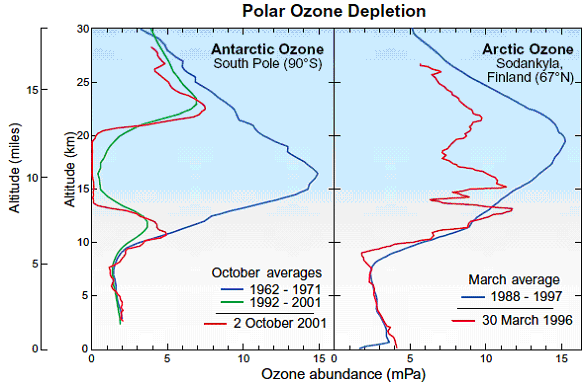 Figure Q11-2. Arctic and Antarctic ozone distribution. The stratospheric ozone layer resides between about 10 and 50 kilometers (6 to 31 miles) above Earth’s surface over the globe. Long-term observations of the ozone layer from small balloons allow the winter Antarctic and Arctic regions to be compared. In the Antarctic at the South Pole, halogen gases have destroyed ozone in the ozone layer beginning in the 1980s. Before that period, the ozone layer was clearly present as shown here using average ozone values from balloon observations made between 1962 and 1971. In more recent years, as shown here for 2 October 2001, ozone is destroyed completely between 14 and 20 kilometers (8 to 12 miles) in the Antarctic in spring. Average October values in the ozone layer now are reduced by 90% from pre-1980 values. The Arctic ozone layer is still present in spring as shown by the average March profile obtained over Finland between 1988 and 1997. However, March Arctic ozone values in some years are often below normal average values as shown here for 30 March 1996. In such years, winter minimum temperatures are generally below PSC formation temperatures for long periods. (Ozone abundances are shown here with the unit “milli-Pascals” (mPa), which is a measure of absolute pressure (100 million mPa = atmospheric sea-level pressure).) 〔NOAA Aeronomy Laboratoryの『International Ozone-Layer Assessments』の『WMO/UNEP Scientific Assessment of Ozone Depletion: 2002』の『Twenty Questions and Answers About the Ozone Layer』の『III STRATOSPHERIC OZONE DEPLETION』の中の『Q11: How severe is the depletion of the Antarctic ozone layer?』から〕 南極と北極上空のオゾン層が破壊されていることを示す観測データ。フロンが犯人であるが、両極とくに南極で破壊が著しいのは極域成層圏雲が重要な役割をしていると考えられている。 |
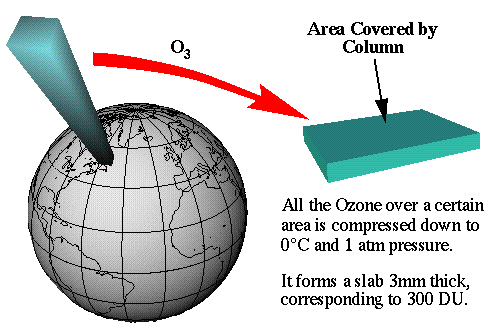 〔Centre for Atmospheric Science(Cambridge University, UK)によるThe Ozone
Hole Tourの中の『Dobson
Unit - Definition』から〕 |
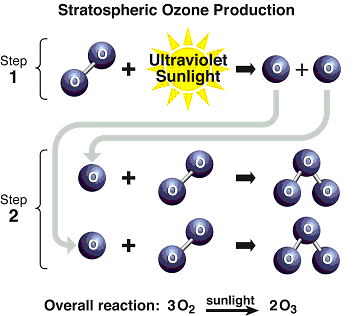 |
Figure Q2-1. Stratospheric ozone production. Ozone is naturally produced in the stratosphere in a two-step process. In the first step, ultraviolet sunlight breaks apart an oxygen molecule to form two separate oxygen atoms. In the second step, these atoms then undergo a binding collision with other oxygen molecules to form two ozone molecules. In the overall process, three oxygen molecules react to form two ozone molecules. |
|
〔NOAA Aeronomy Laboratoryの『International Ozone-Layer Assessments』の『WMO/UNEP Scientific Assessment of Ozone Depletion: 2002』の『Twenty Questions and Answers About the Ozone Layer』の『I OZONE IN OUR ATMOSPHERE』の中の『Q2: How is ozone formed in the atmosphere?』から〕 酸素分子から太陽紫外線のはたらきでオゾン(分子)が生成する反応式。これは、自然の作用である。 |
|
| 極域成層圏雲(Polar stratospheric cloud、PSC) |
オゾンホールの生成(オゾンの破壊)には、極(域)成層圏雲の働きが大きいことが知られている。南極や北極の上空(20〜30km程度)の成層圏に発生する硫酸と硝酸(と水)を主とする雲であり、超低温(-70〜-80℃)の条件下で成長する。オゾンを破壊する塩素原子(Cl)を、冬季の間は破壊能力の低い他の塩素化合物の形で捕捉し、春季に増大する太陽光の作用によって塩素原子として放出して急激なオゾン層破壊を引き起こす。
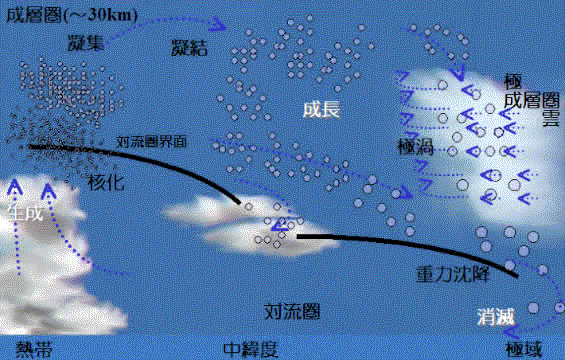 図1.1 成層圏エアロゾルのライフサイクル概念図  図1.2 硝酸水和物・硫酸水和物・Iceの安定領域及び相遷移 凡例(番号) 富士通エフ・アイ・ビー(HP/2010)による『エアロゾル』から |
| オゾン消滅反応 |
オゾン層は、チャップマン機構(反応)により示されるような太陽光の紫外線による作用によって酸素分子(O2)から生成したオゾン(O3)によって形成される。ただし、それ以外の窒素(NOxサイクル)や水素(HOxサイクル)や塩素(ClOxサイクル)などの、オゾンを消滅させる反応も生じている。これらがバランスした状態にあるのが本来のオゾン層である。
ここに、人類が放出するフロンなどから発生した塩素が、急激にオゾン層を破壊していることが明らかになった。特に極(域)成層圏雲の働きによる南極上空のオゾン層の穴であるオゾンホールの発生は良く知られている。
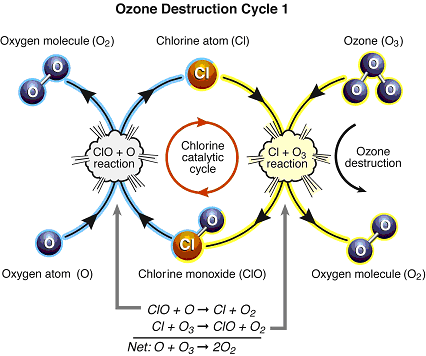 |
Figure Q9-1. Ozone destruction Cycle 1. The destruction of ozone in Cycle 1 involves two separate chemical reactions. The net or overall reaction is that of atomic oxygen with ozone, forming two oxygen molecules. The cycle can be considered to begin with either ClO or Cl. When starting with ClO, the first reaction is ClO with O to form Cl. Cl then reacts with (and thereby destroys) ozone and reforms ClO. The cycle then begins again with another reaction of ClO with O. Because Cl or ClO is reformed each time an ozone molecule is destroyed, chlorine is considered a catalyst for ozone destruction. Atomic oxygen (O) is formed when ultraviolet sunlight reacts with ozone and oxygen molecules. Cycle 1 is most important in the stratosphere at tropical and middle latitudes where ultraviolet sunlight is most intense. |
|
〔NOAA Aeronomy Laboratoryの『International Ozone-Layer Assessments』の『WMO/UNEP Scientific Assessment of Ozone Depletion: 2002』の『Twenty Questions and Answers About the Ozone Layer』の『II THE OZONE DEPLETION PROCESS』の中の『Q9: What are the chlorine and bromine reactions that destroy stratospheric ozone?』から〕 生成したオゾンを破壊する反応のひとつである塩素サイクル。これも、自然の作用であるが、人間がつくったフロンから生成した塩素がオゾン層を破壊するという環境問題によって注目されている。 |
|
| オゾンホール |
/Image2430.gif) 図1 オゾンホールの面積の推移 オゾンホールの規模を示す要素の一つであるオゾンホールの面積(オゾン全量が220m atm-cm以下の領域の面積)の推移。赤線は2012年、青線は2011年、黒線は過去10年(2002〜2011年)の平均値です。濃い紫色の領域の上端と下端は2002〜2011年の最大値・最小値を表しています。また、緑色の横線は南極大陸の面積です。米国航空宇宙局(NASA)提供の衛星観測データ(TOMSおよびOMIデータ)をもとに作成。2012年10月20日までのデータで描画。 |
/Image2464.gif) 図2 2012年9月22日のオゾン全量南半球分布図 中央の灰色の部分がオゾンホール。図の中央部および放射状に細長く広がっている白い領域は、衛星データが欠測となった領域です。図中の▲印は、昭和基地の位置(南緯69度、東経39度付近)を示しています。米国航空宇宙局(NASA)提供の衛星観測データ(OMIデータ)をもとに作成。 |
/Image2465.gif) 図3 2012年8、9月の月平均オゾン分圧の高度分布グラフ(南極昭和基地) 赤線:実線は観測値の月平均値。細実線:月の参照値(1994〜2008年平均)、横細実線:参照値の標準偏差。点線:オゾンホールが明瞭に現れる以前の月平均値(1968〜1980年平均)。オゾン分圧(横軸)が大きいほど、その層のオゾン量が多いことを示します。 【参考】過去の月平均オゾン分圧の高度分布グラフ |
|
| 気象庁(HP/2012/11)による『オゾンホールの年間推移』から | |
 〔NASA earth observatoryの『News』の『New Images』の中の『Largest-ever Ozone Hole over Antarctica』から〕 |
| フロン |
ウィキペディア(HP/2012/12)による『オゾン破壊係数』から |
|||||||||||||||||||||||||||||||||||||||||||||||||||||||||||||||||||||||||||||||||||||||||||||||||||||||||||||||||||||||
|
狭義の「フロン」は炭素・フッ素・塩素のみからなるクロロフルオロカーボン (CFC) を指すが、塩素を含まないフルオロカーボン (FC) や、水素を含むハイドロクロロフルオロカーボン (HCFC) およびハイドロフルオロカーボン (HFC)、臭素を含むハロンも含める場合がある。 ウィキペディア(HP/2012/12)による『フロン類』から |
| 紫外線 |
|
||||||||||||||||||||||||||||||||||||||||||||||||||||||||
/Image2696.gif) Levels of ozone at various altitudes and blocking of different bands of ultraviolet radiation. Essentially all UVC is blocked by dioxygen (from 100-200 nm) or by ozone (200-280 nm) in the atmosphere. The ozone layer then blocks most UVB. Meanwhile, UVA is hardly affected by ozone and most of it reaches the ground. |
/Image2697.gif) The reddening of the skin due to the action of sunlight depends both on the amount of sunlight and on the sensitivity of the skin ("erythemal action spectrum") over the UV spectrum. |
|||||||||||||||||||||||||||||||||||||||||||||||||||||||
| Wikipedia(HP/2012/12)による『Ultraviolet』から | ||||||||||||||||||||||||||||||||||||||||||||||||||||||||
ウィキペディア(HP/2012/12)による『紫外線』から |
||||||||||||||||||||||||||